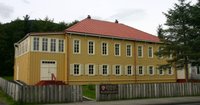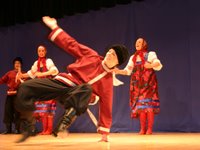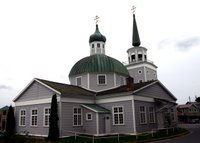Sitka's Russian Influence
The Russians were the first whites to discover and claim Alaska in 1741. They settled primarily along the southea stern coast and came to Sitka in 1790. Their influence is still prominent in Sitka. They were fascinated with Alaskan furs, especially those from otters.
stern coast and came to Sitka in 1790. Their influence is still prominent in Sitka. They were fascinated with Alaskan furs, especially those from otters.  They hunted them until the otters were nearly extinct. Eventually, Russia could no longer support their Russian Alaska colony, as the otter furs were becoming scarce, and other nations were moving into their trading territory. In 1867 they sold Alaska to the U.S. for nine cents an acre. The Russian flag came down in Sitka on Castle Hill, the old Russian Headquarters. Sitka then became Alaska’s first capital. In 1959, the U.S. flag with 49 stars first flew over Castle Hill. America’s smallest National Cemetery is located in Sitka. Among the prominent people buried there are a medal of honor winner, an U.S. Olympics champion runner (called the “fastest man in the world” in 1920), and Gov. Brady.
They hunted them until the otters were nearly extinct. Eventually, Russia could no longer support their Russian Alaska colony, as the otter furs were becoming scarce, and other nations were moving into their trading territory. In 1867 they sold Alaska to the U.S. for nine cents an acre. The Russian flag came down in Sitka on Castle Hill, the old Russian Headquarters. Sitka then became Alaska’s first capital. In 1959, the U.S. flag with 49 stars first flew over Castle Hill. America’s smallest National Cemetery is located in Sitka. Among the prominent people buried there are a medal of honor winner, an U.S. Olympics champion runner (called the “fastest man in the world” in 1920), and Gov. Brady.
When the Russian government gave up on Alaska, the Russian Orthodox Church stayed. St. Michael’s Church is a fine example of Russian architecture and is prominently located in the center of the town. The nearby Bishop’s House is a National Historic Site, and is one of four original Russian buildings in Alaska. Sitka is famous for its New Archangel Dancers. Trained by Russian choreographers, the dancers perform Russian, Mol dovian, and Ukrainian folk dances. Interestingly the dancers are not Russian, and their com
dovian, and Ukrainian folk dances. Interestingly the dancers are not Russian, and their com pany is for women only. Some of them work in various professions, while others are housewives. They are talented, agile and exciting to watch in their colorful, authentic costumes. They dance for exercise and fun rather than money. They have been invited to perform all over the world. We thought they were terrific!
pany is for women only. Some of them work in various professions, while others are housewives. They are talented, agile and exciting to watch in their colorful, authentic costumes. They dance for exercise and fun rather than money. They have been invited to perform all over the world. We thought they were terrific!

0 Comments:
Post a Comment
<< Home